
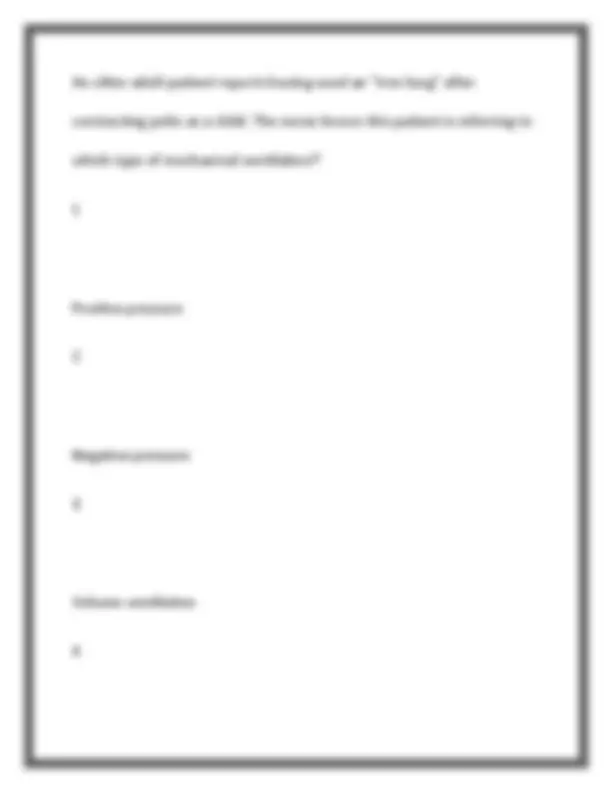
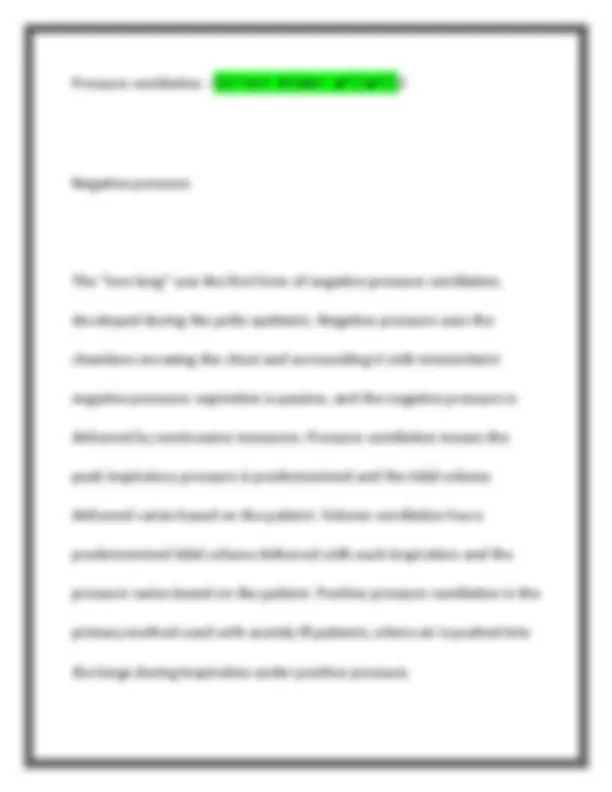
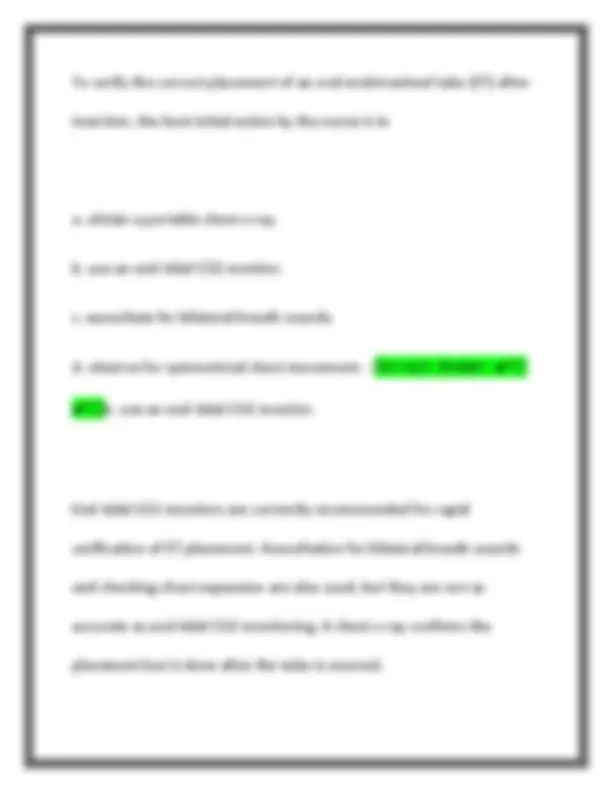
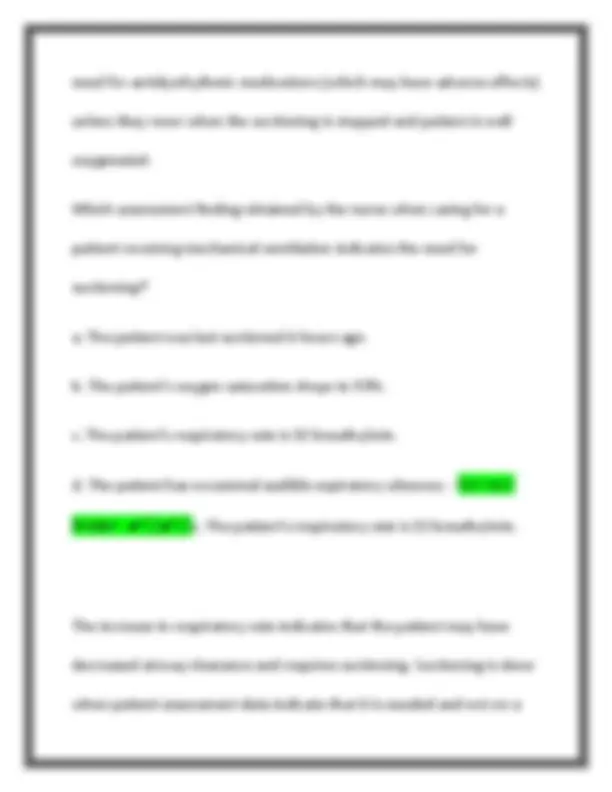
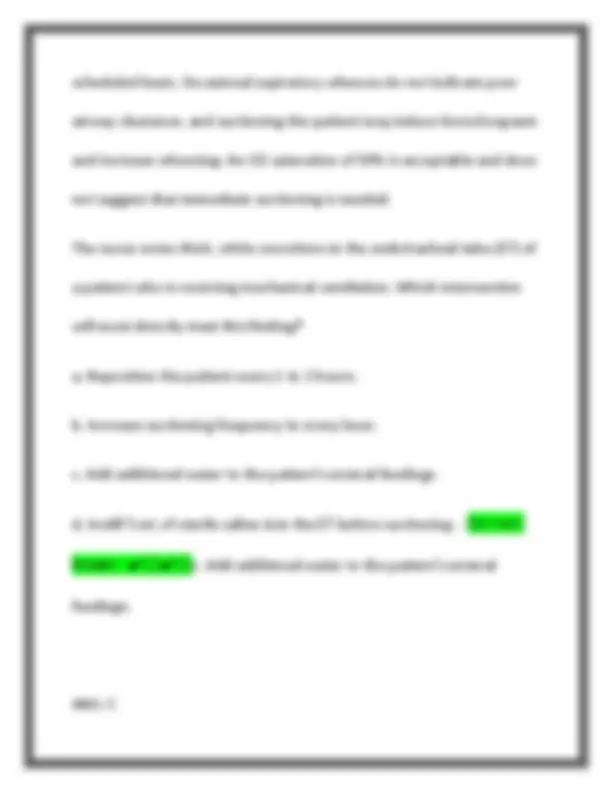
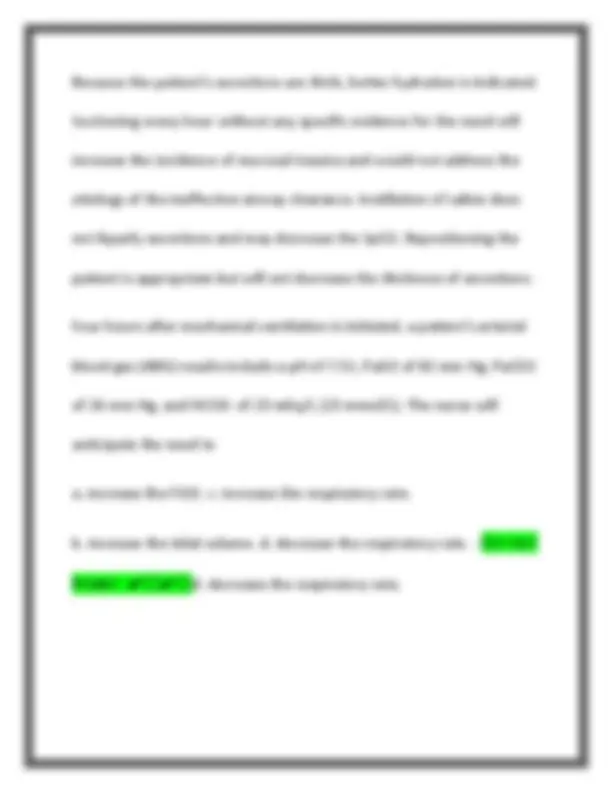
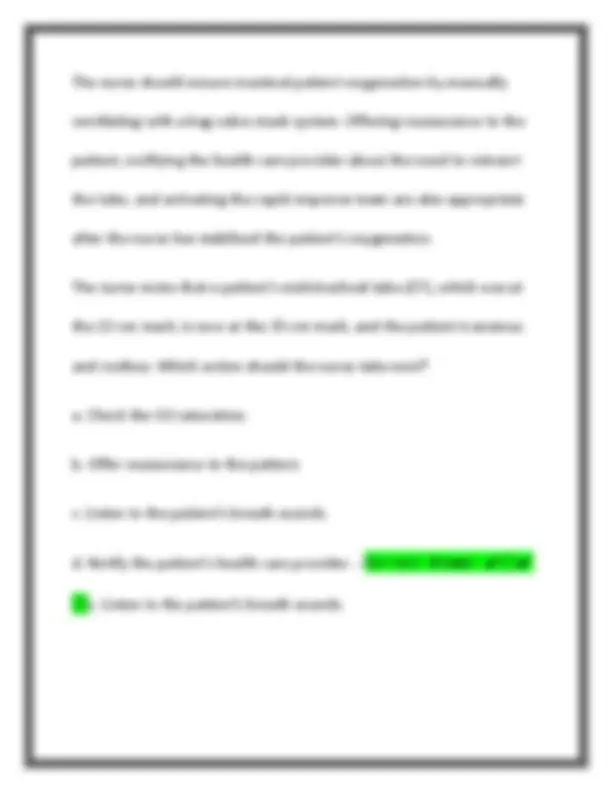
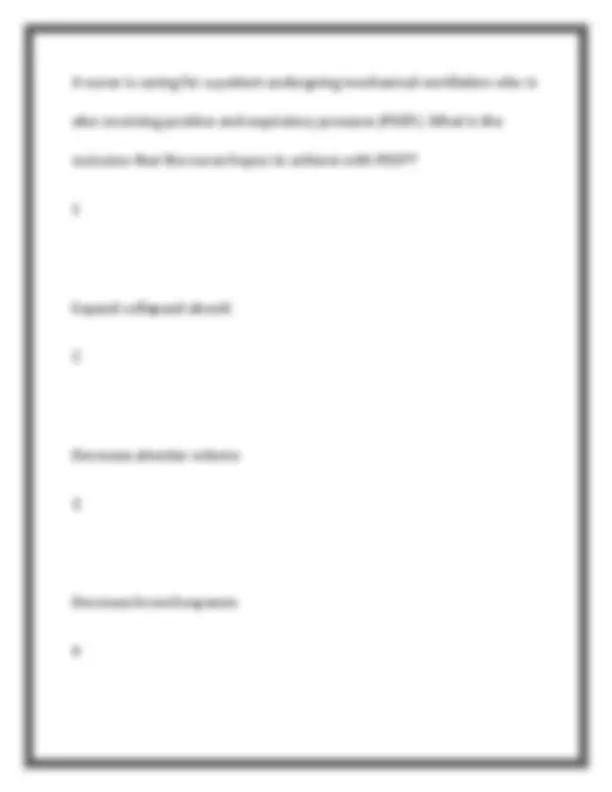
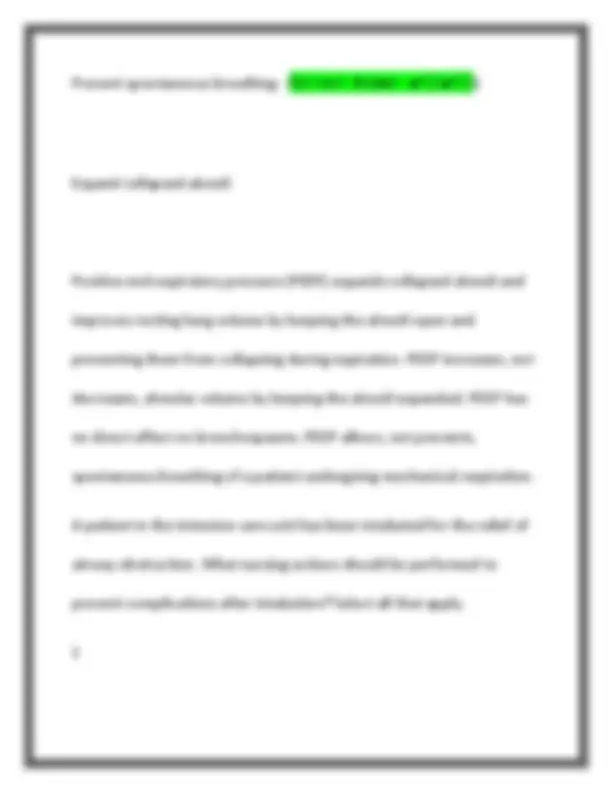
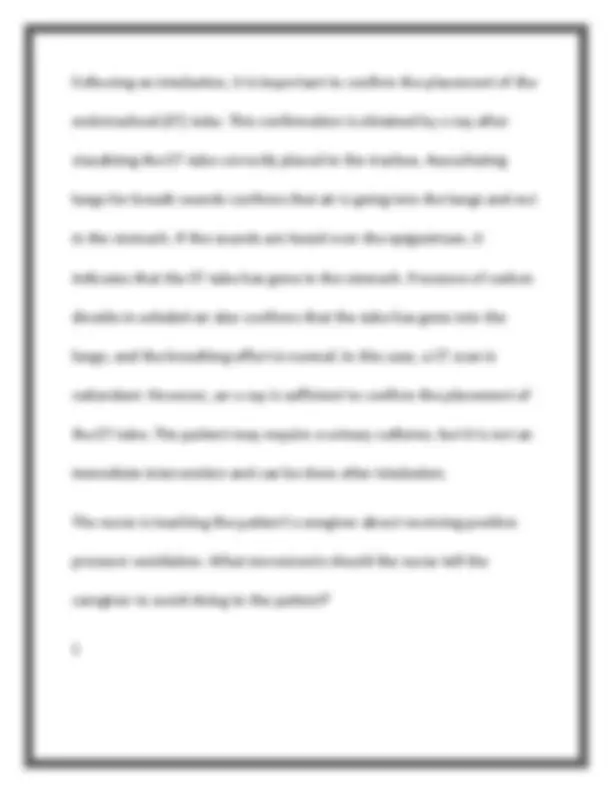
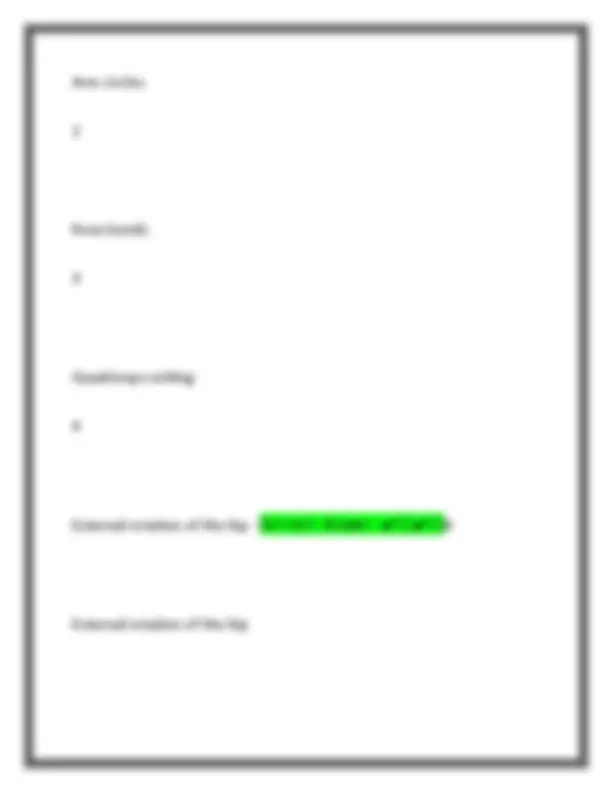
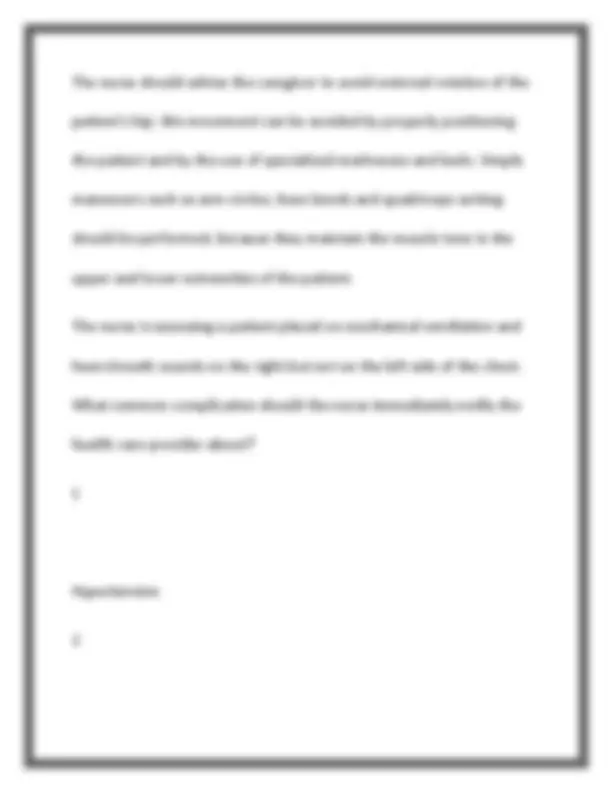
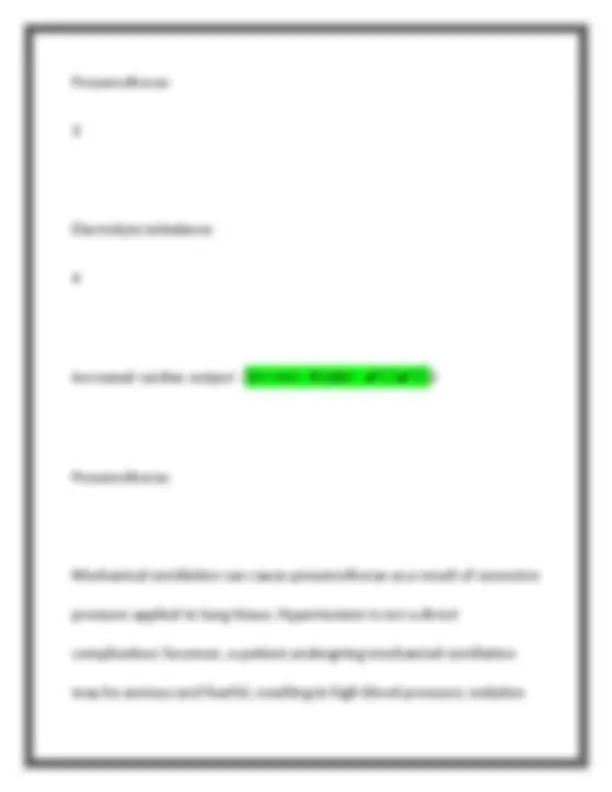
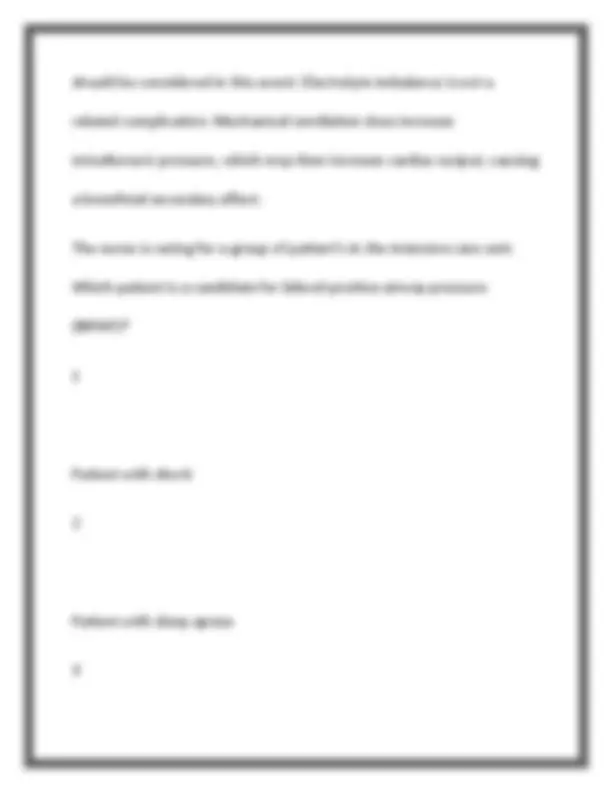
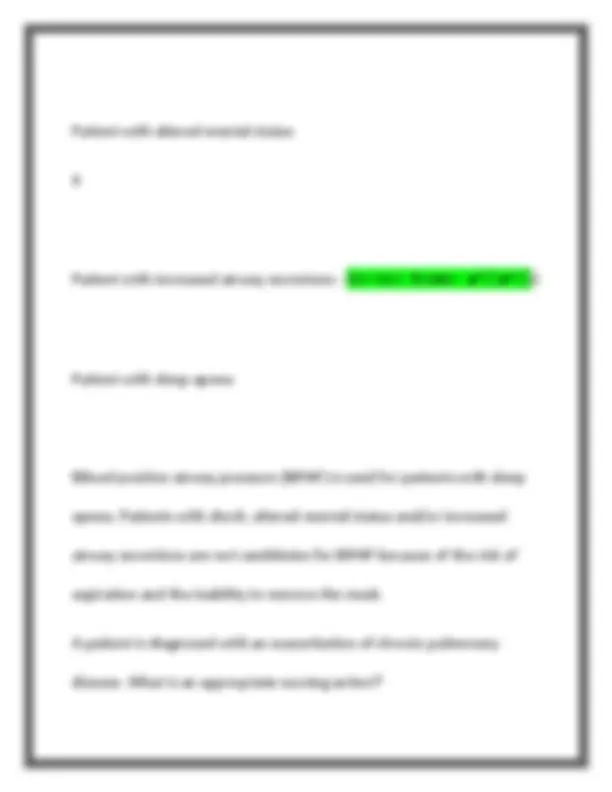
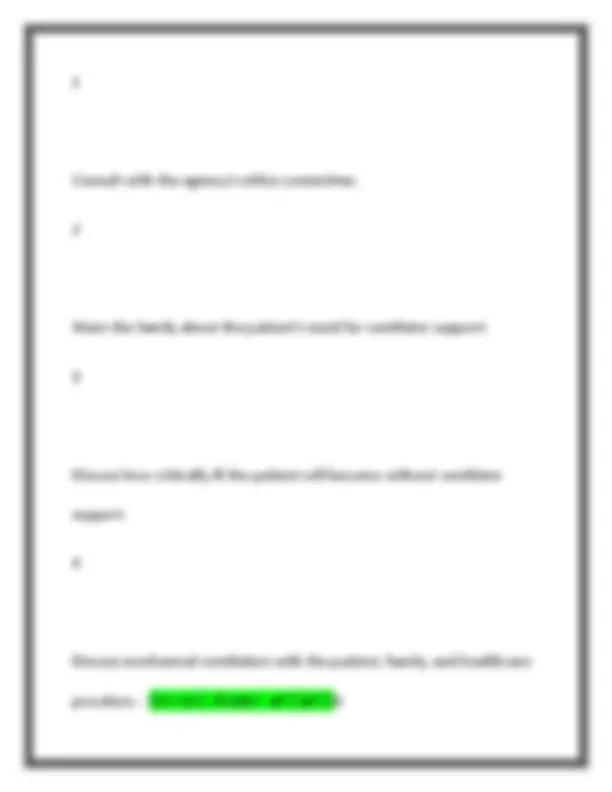
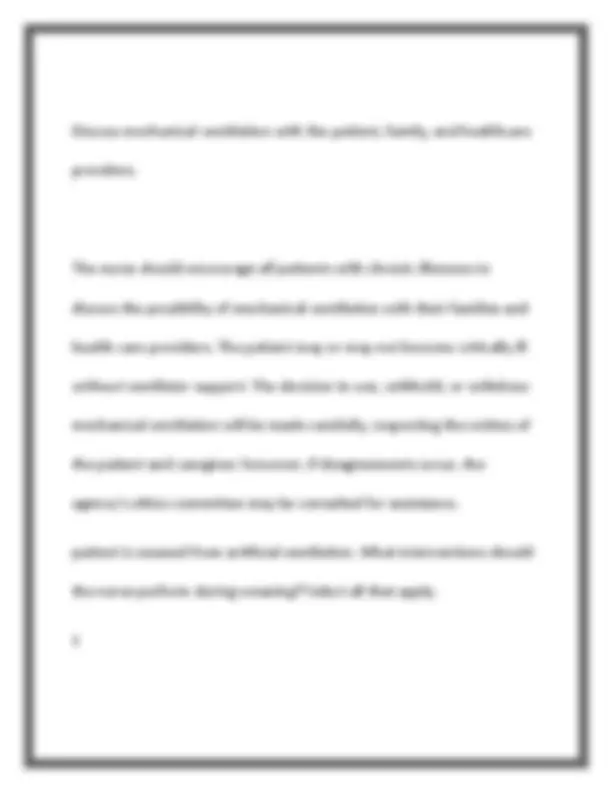
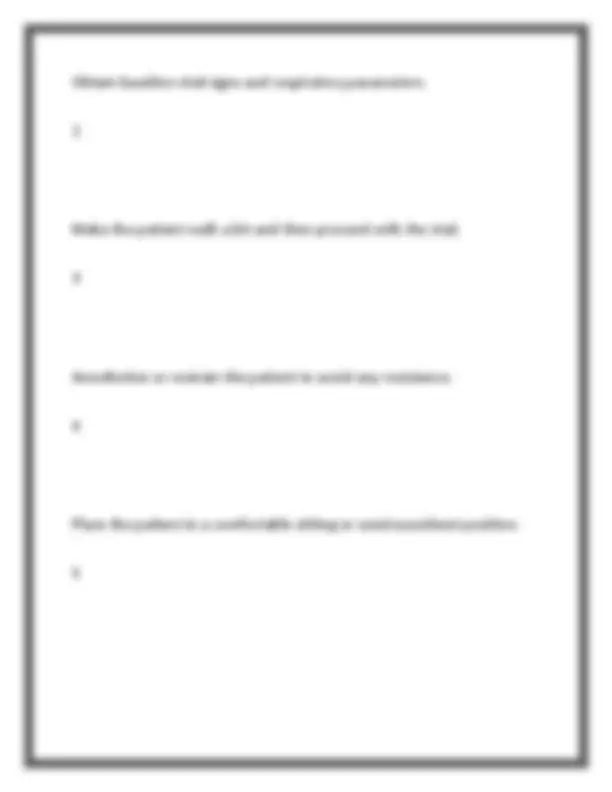
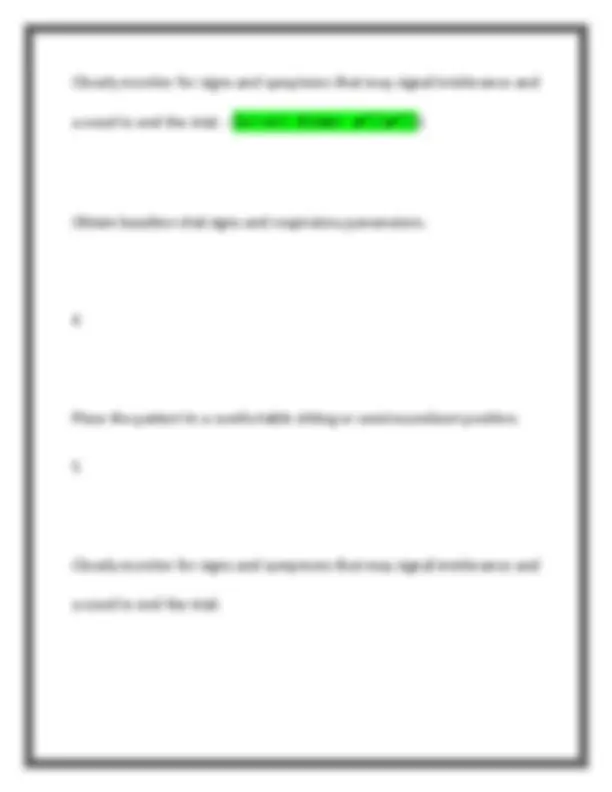
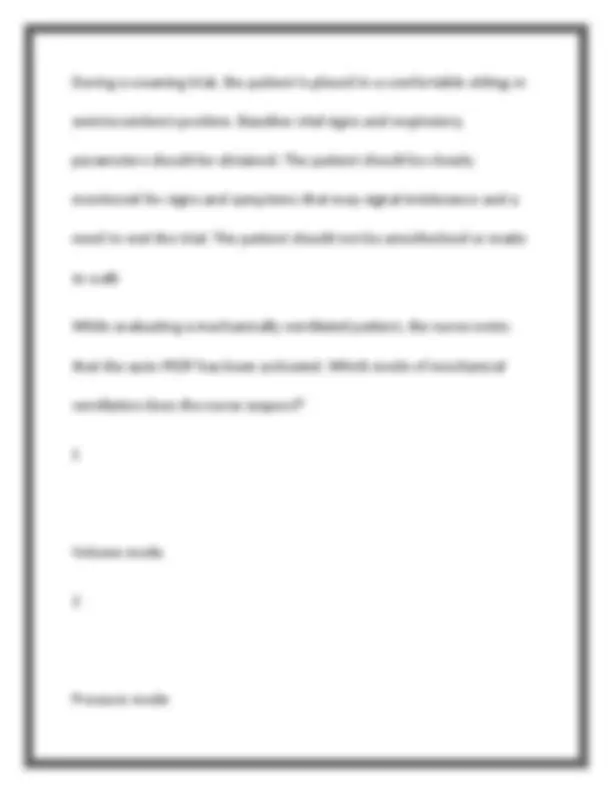
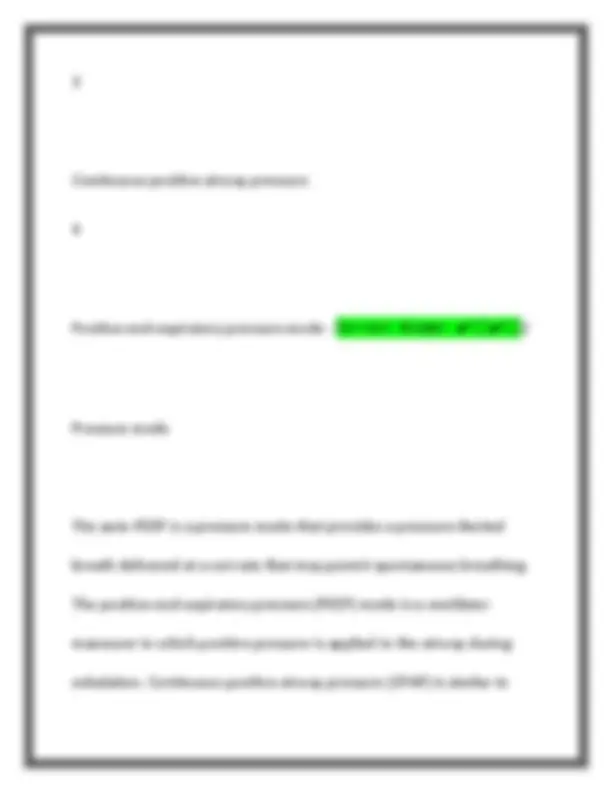
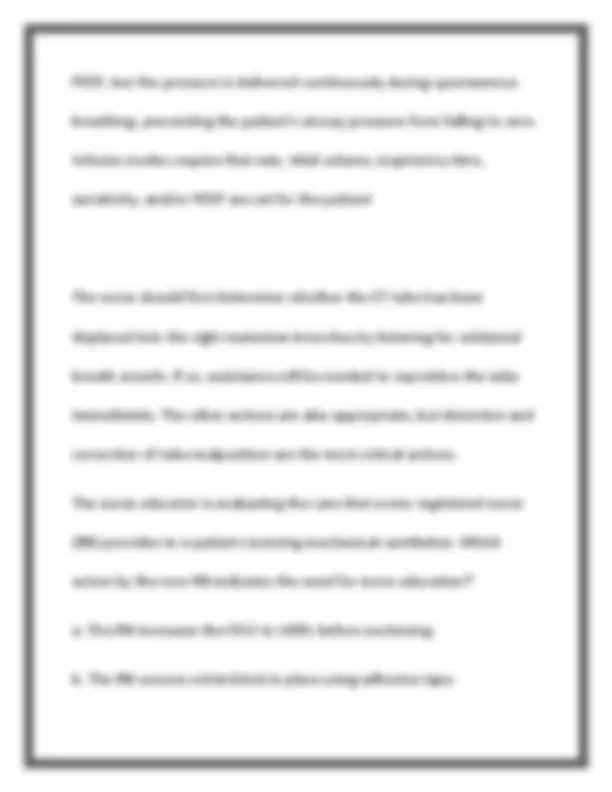
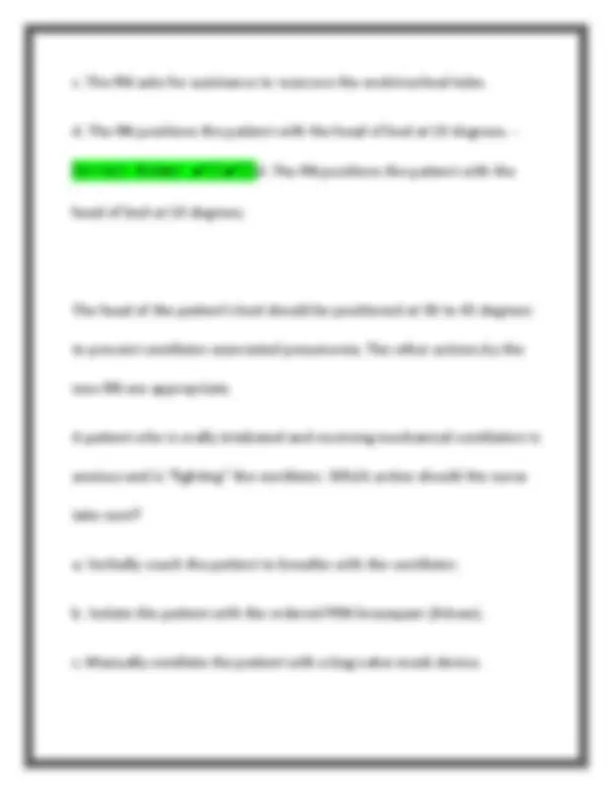

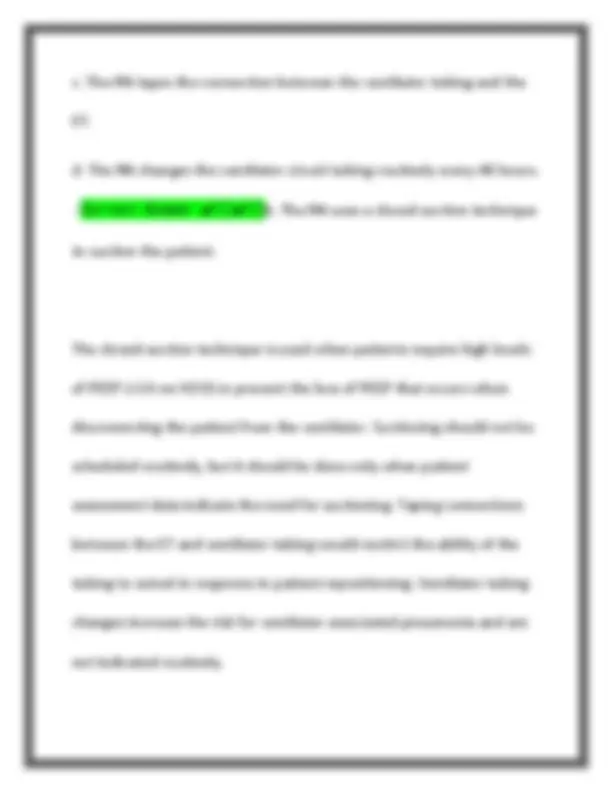
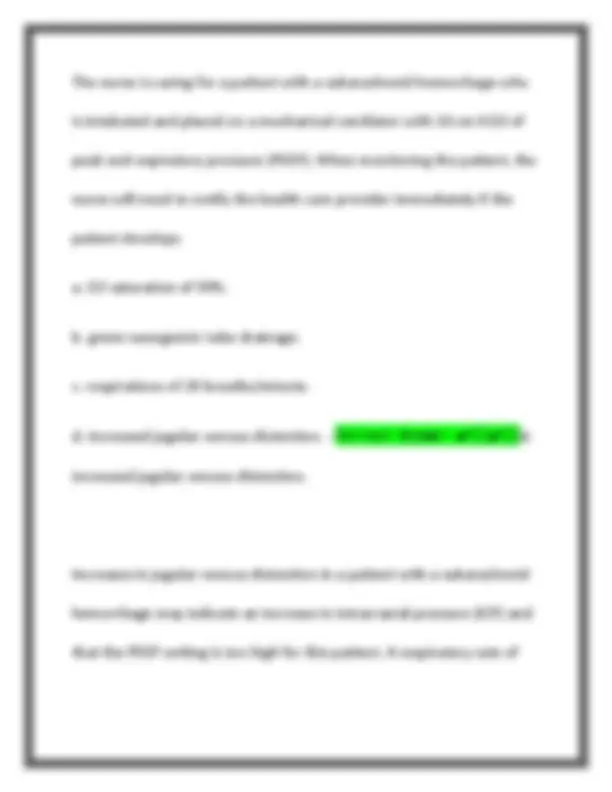
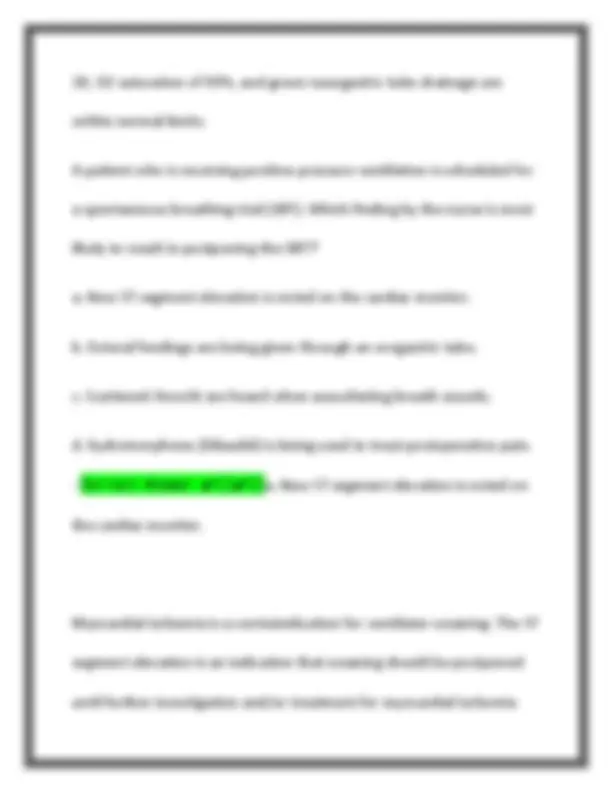
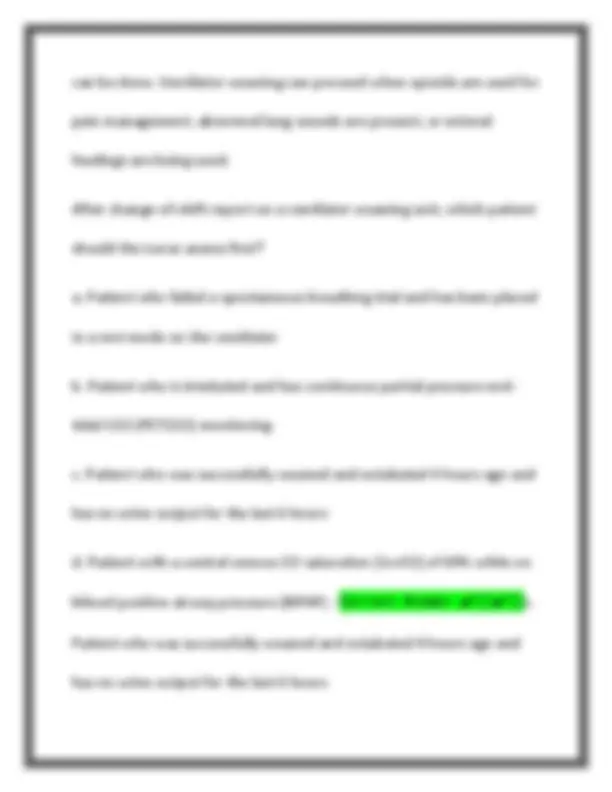
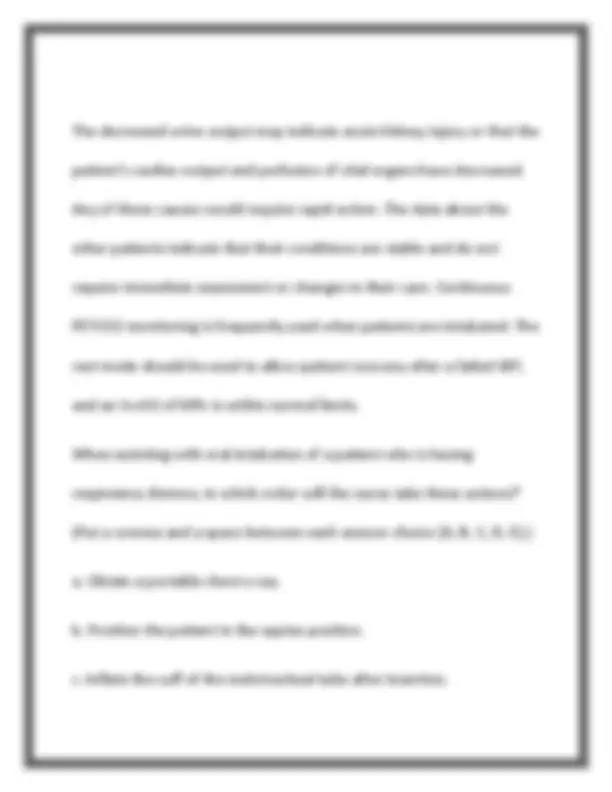
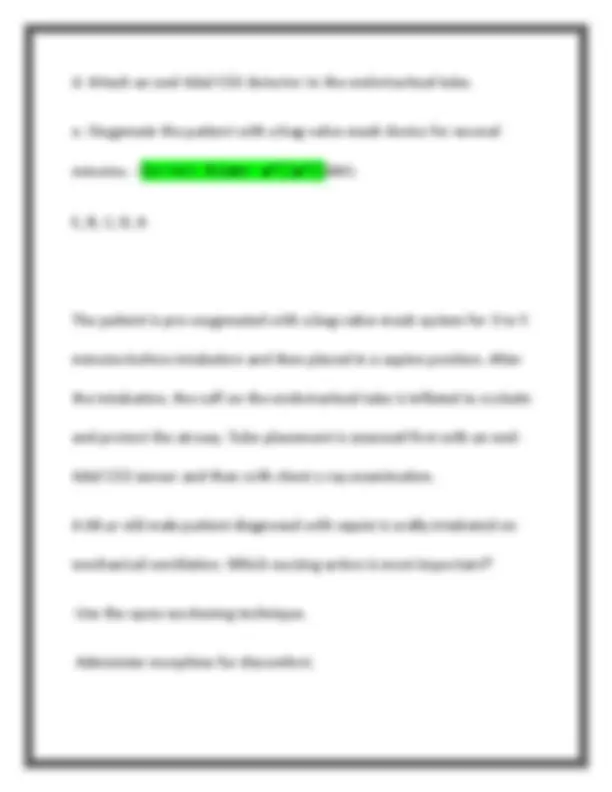
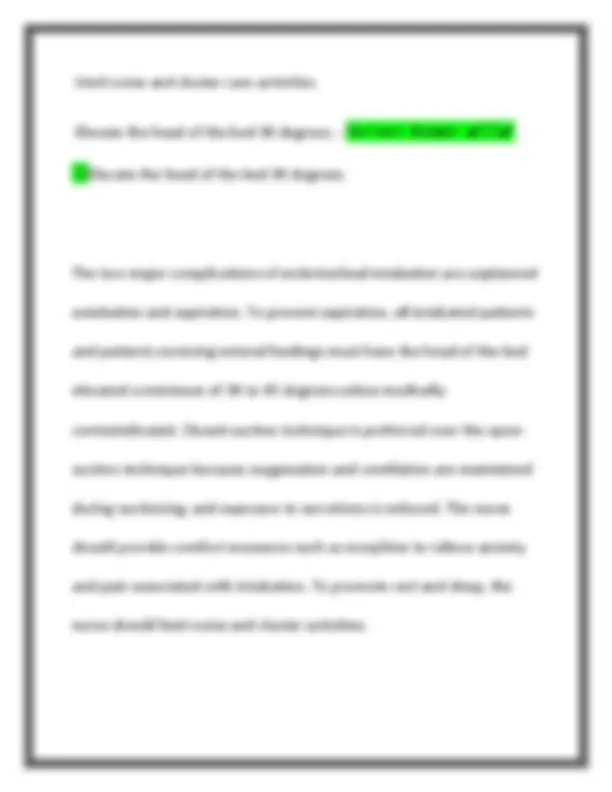
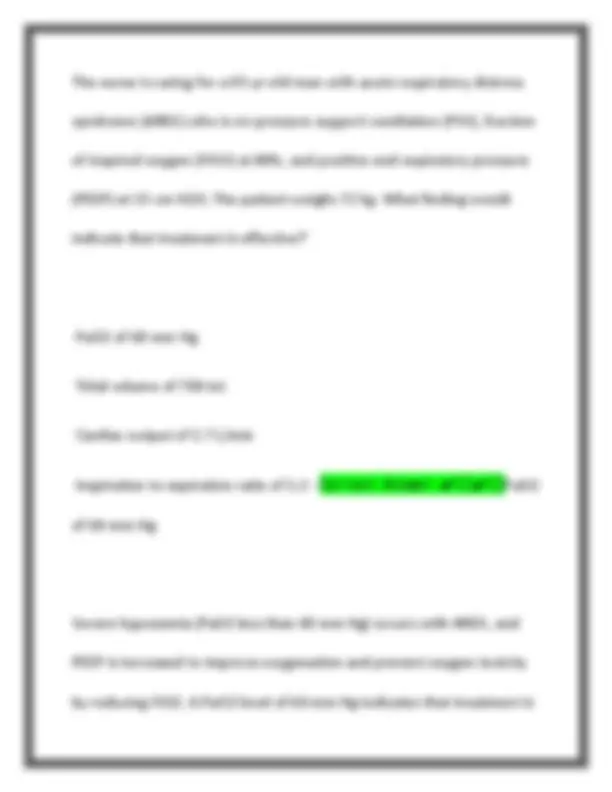
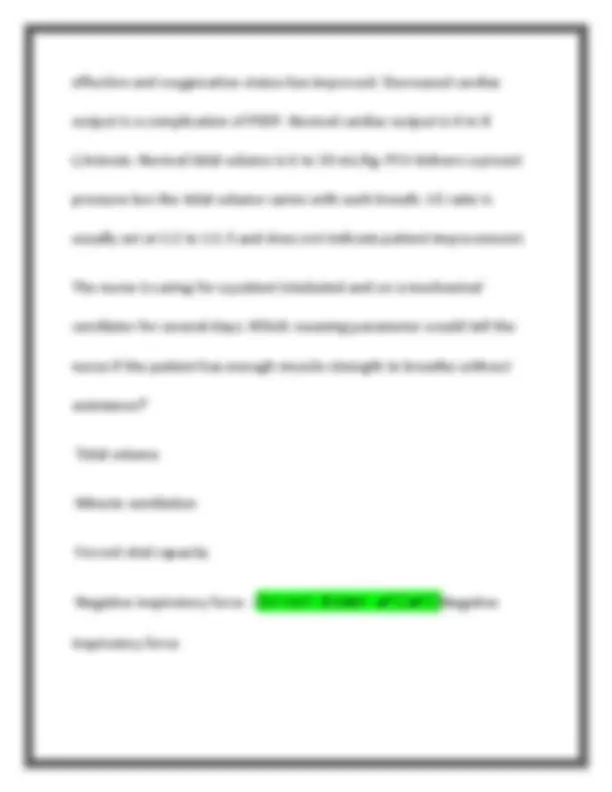
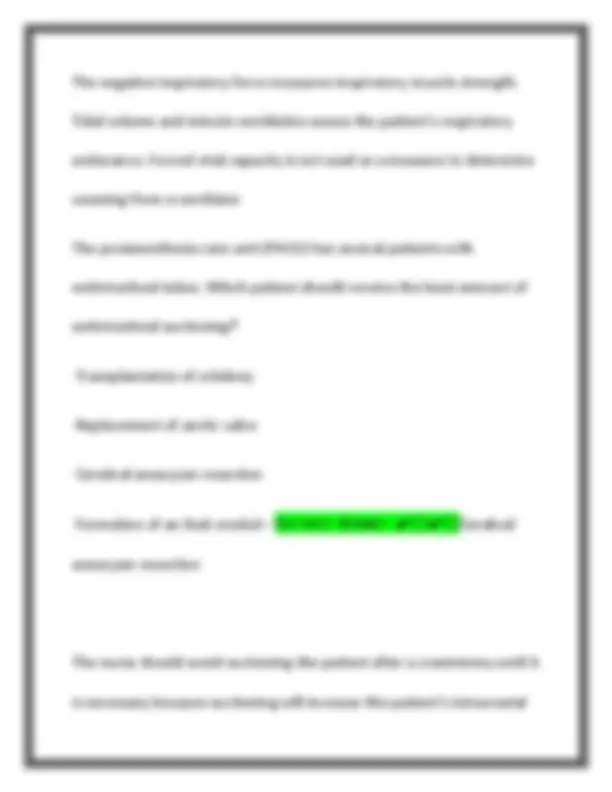
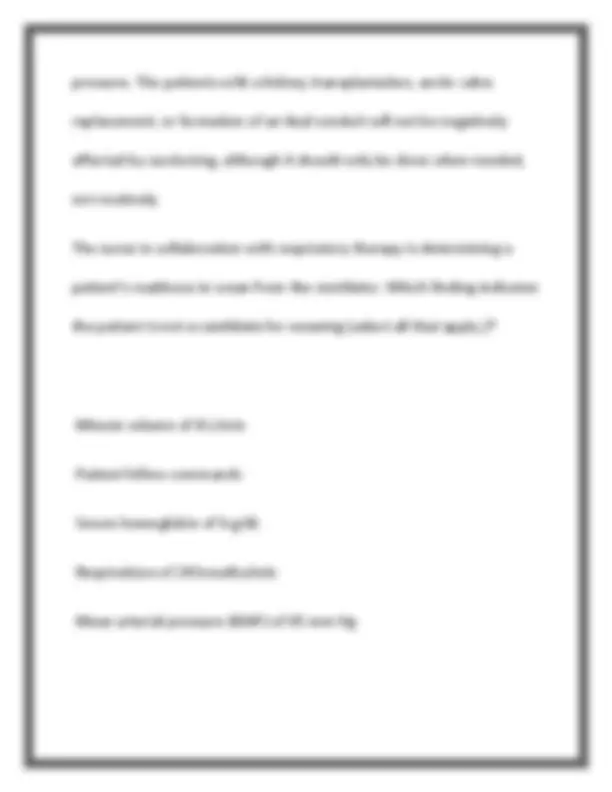
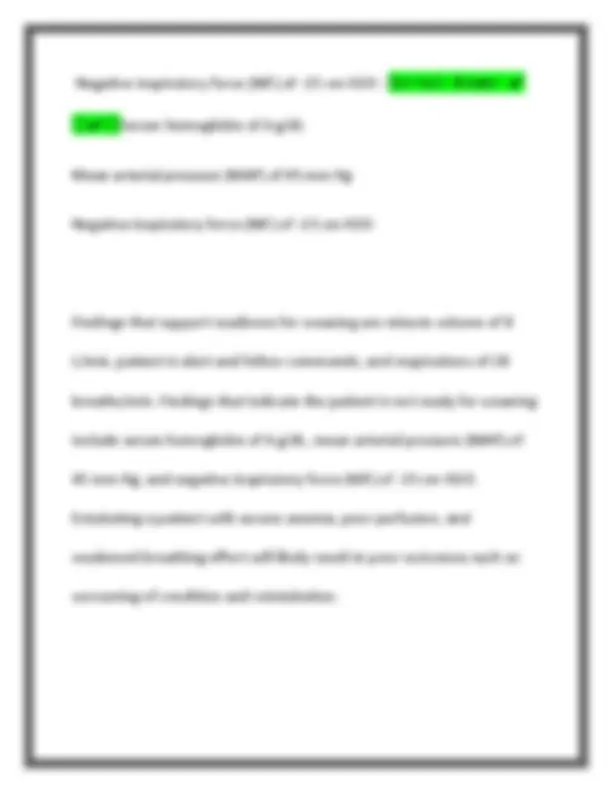
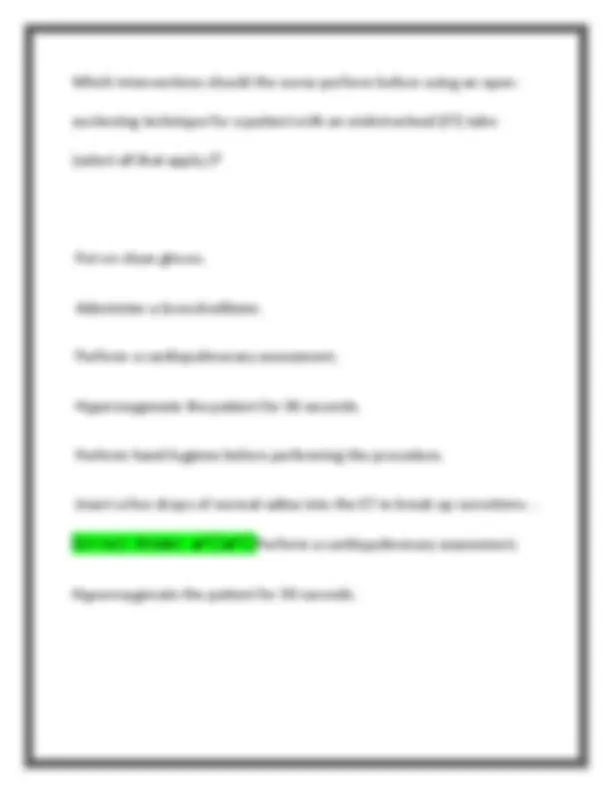
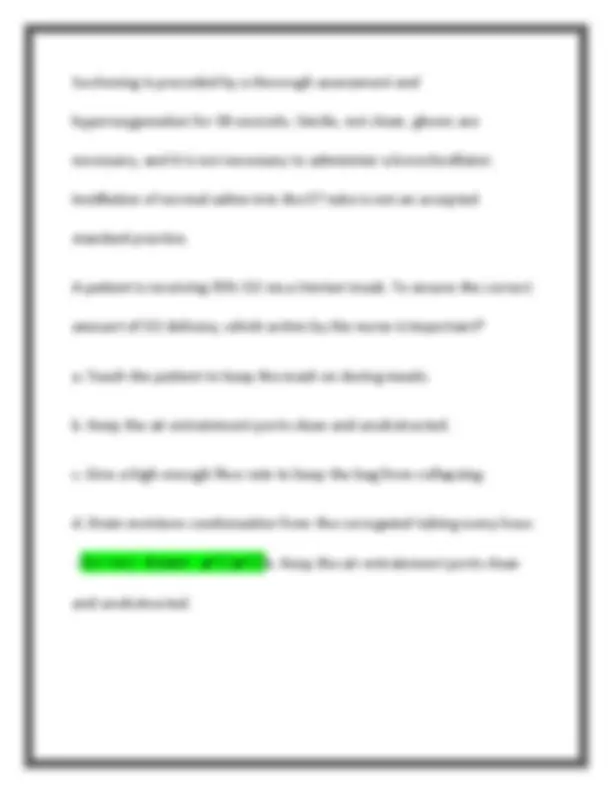
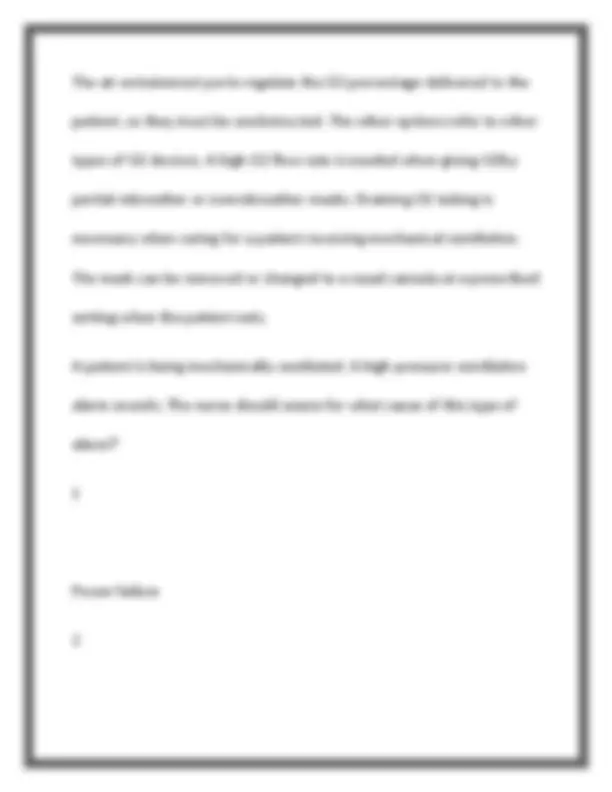
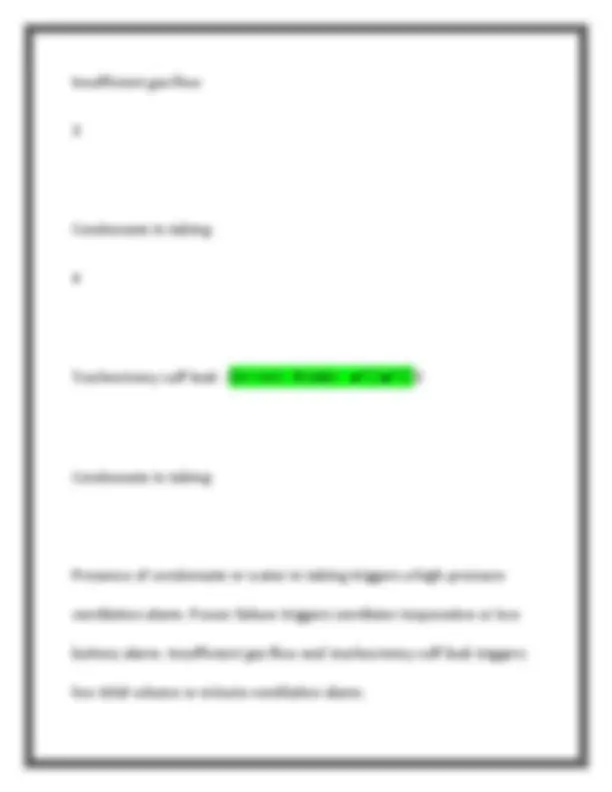
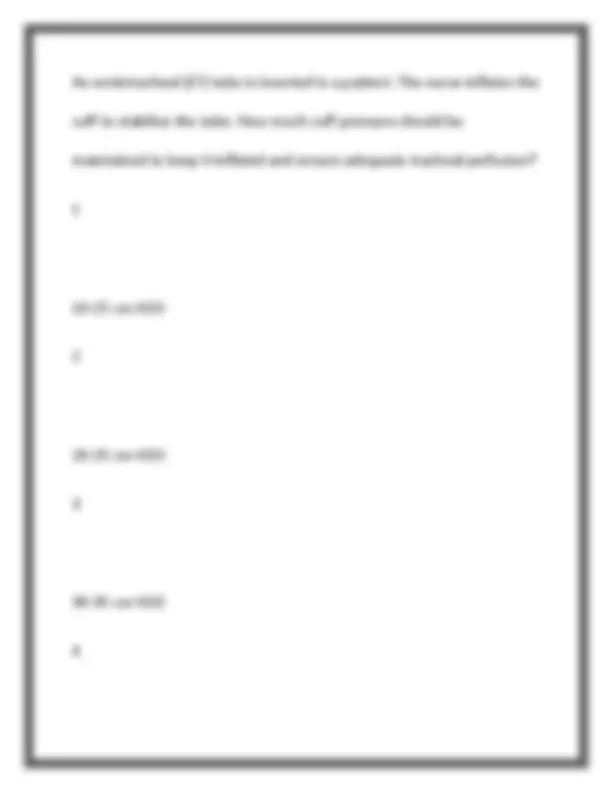
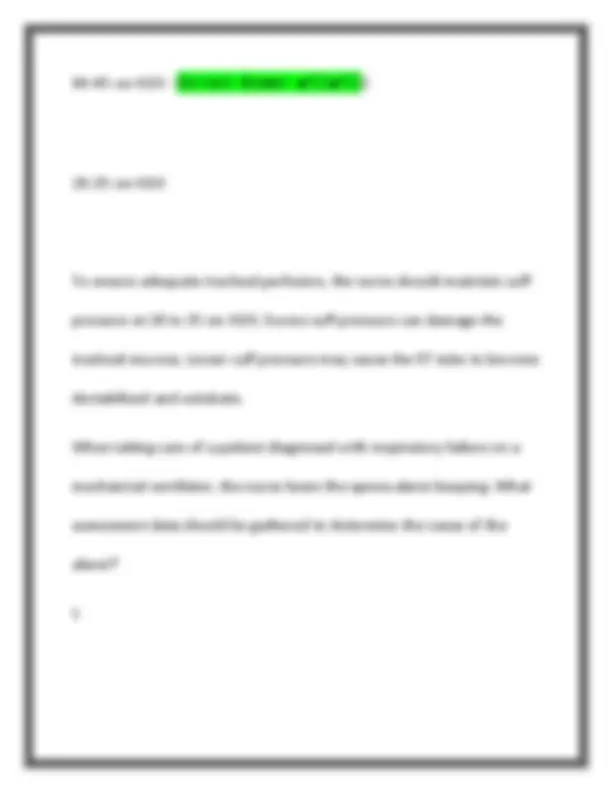
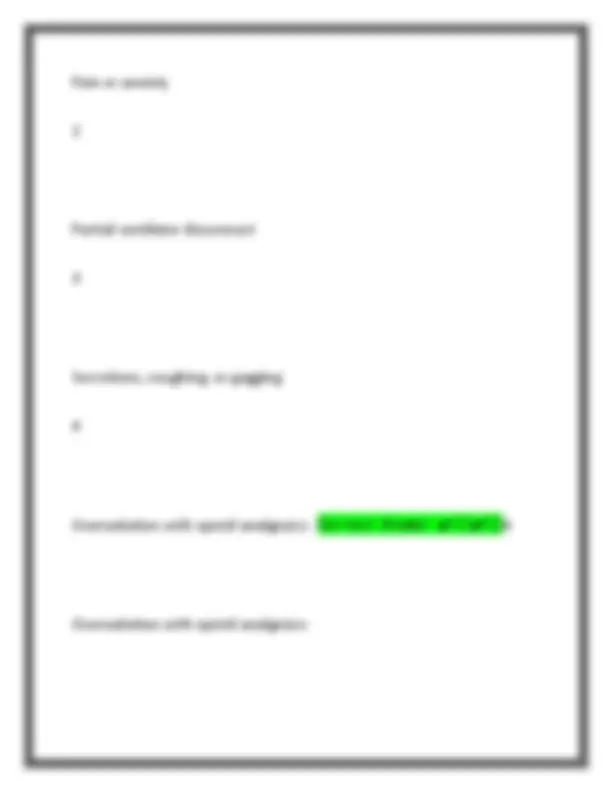
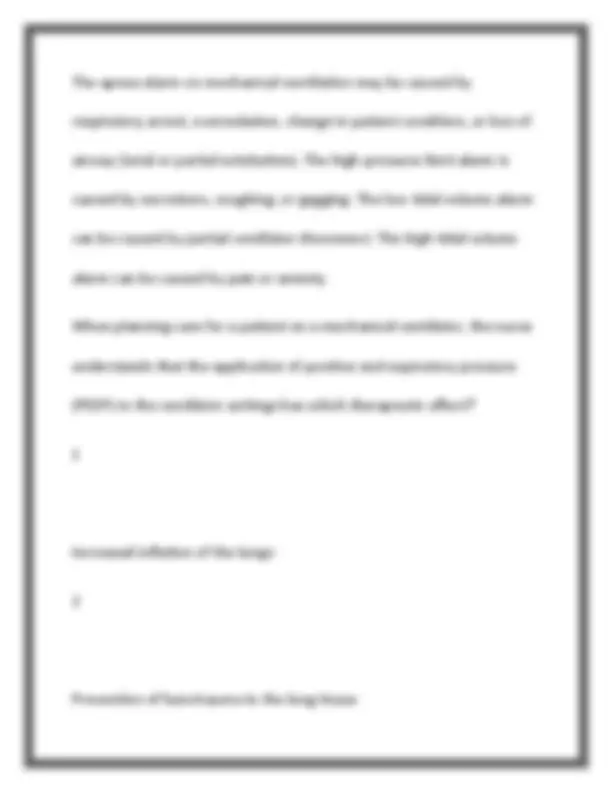
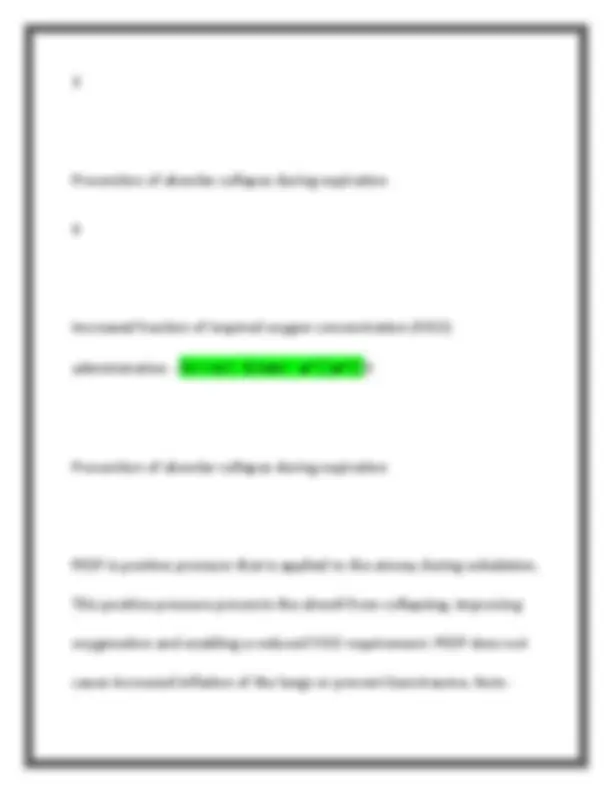
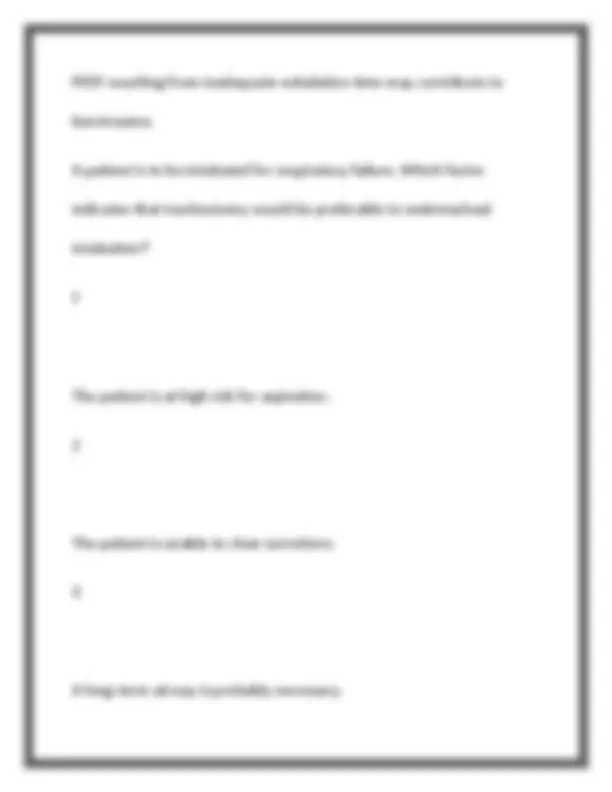
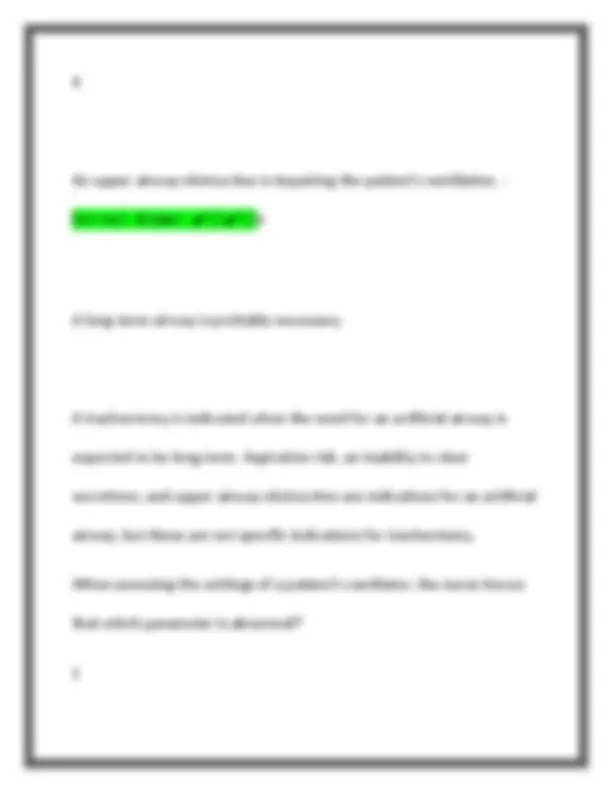
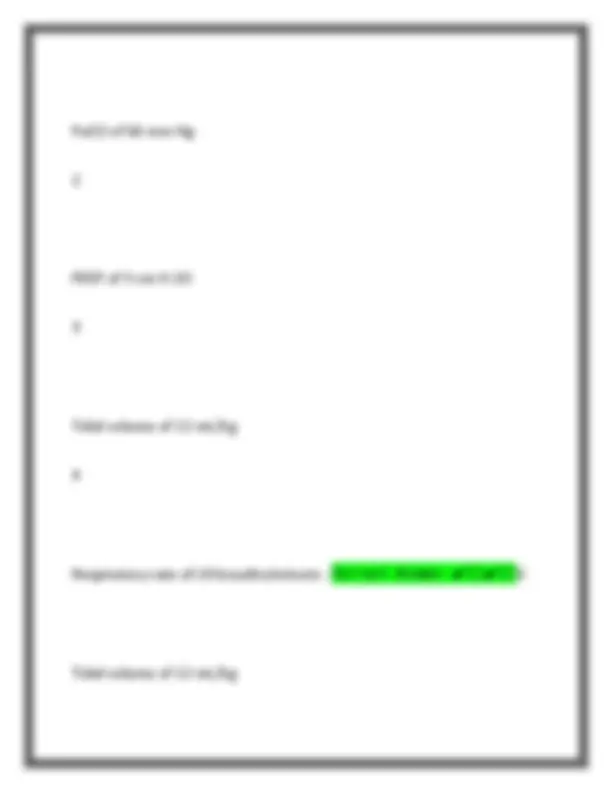
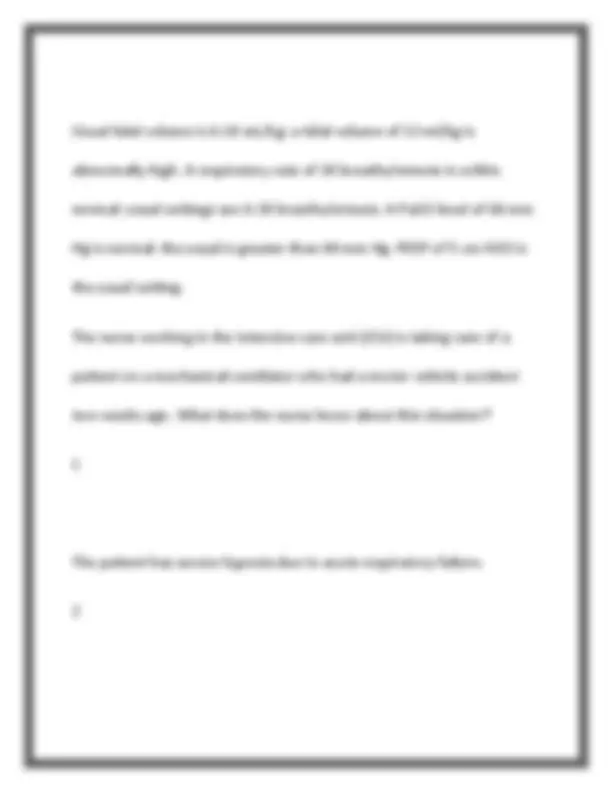
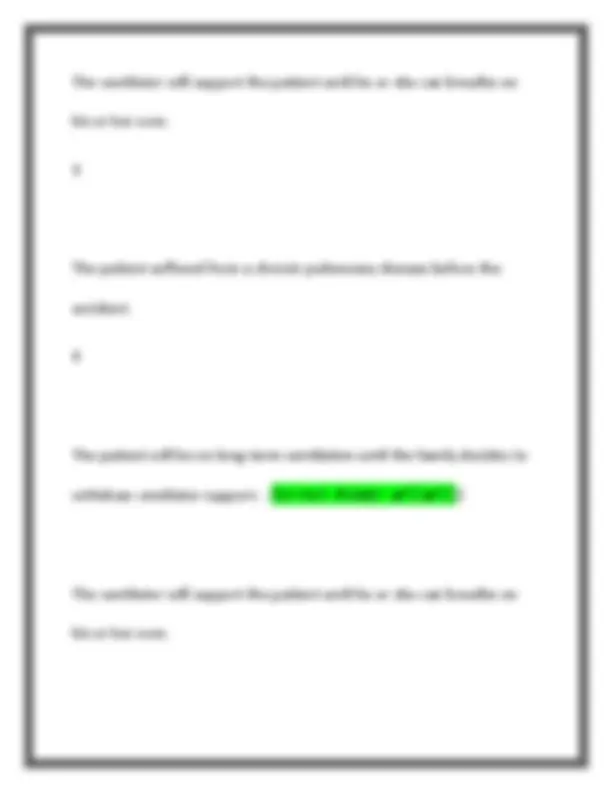
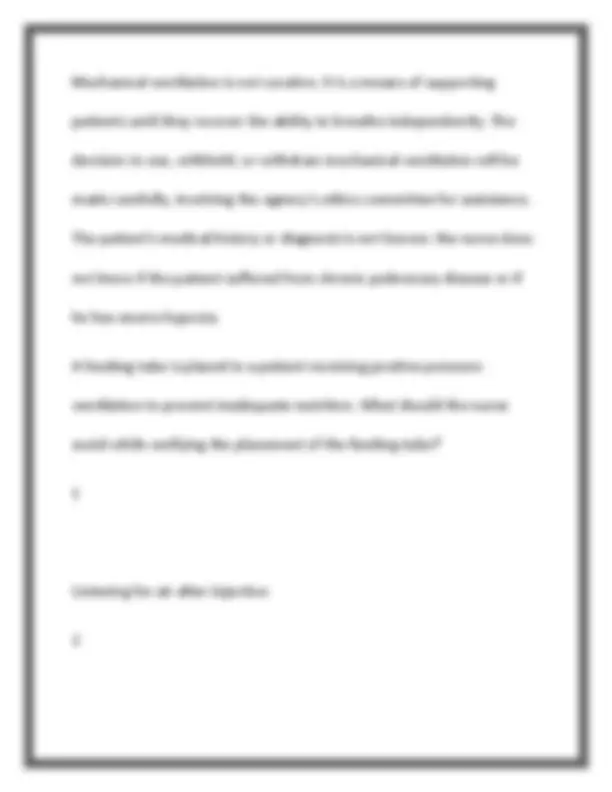
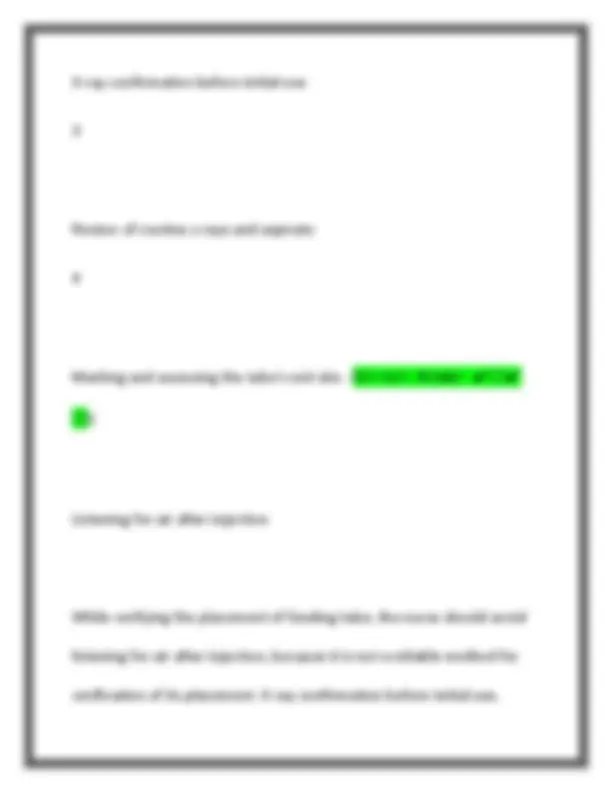
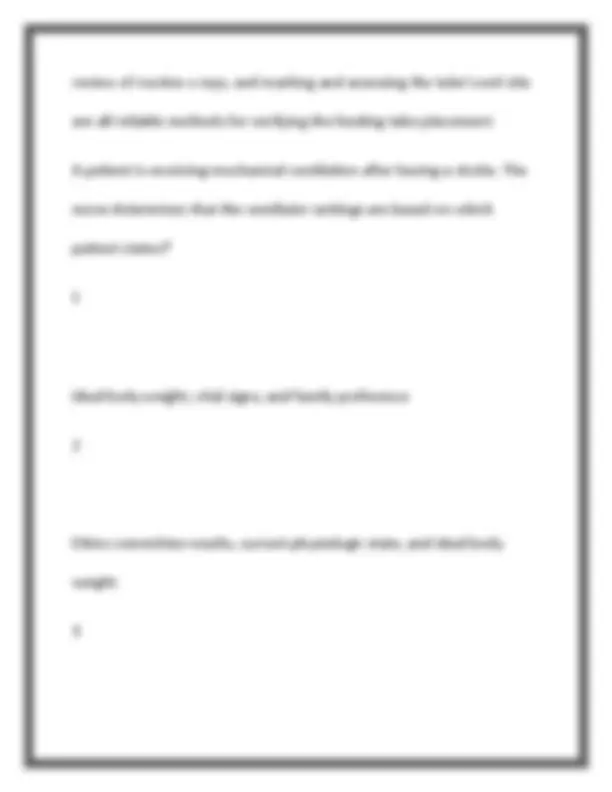
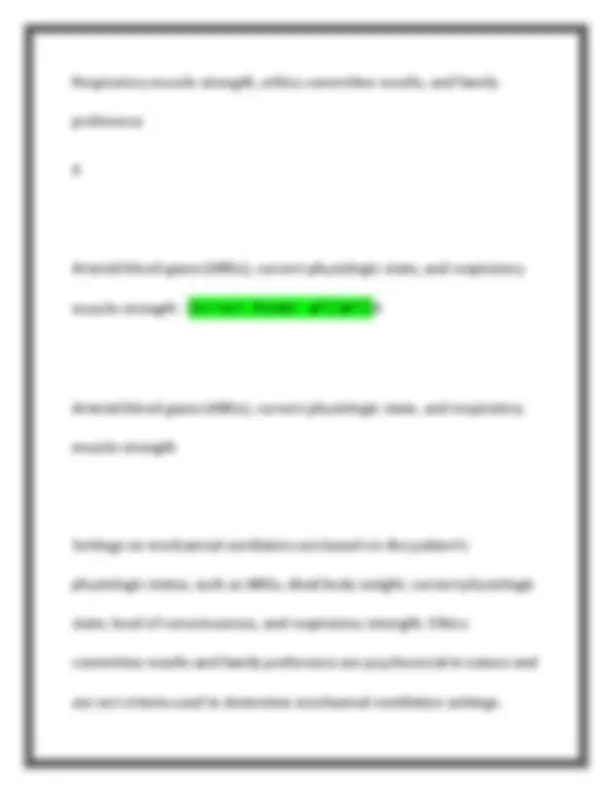


Study with the several resources on Docsity

Earn points by helping other students or get them with a premium plan


Prepare for your exams
Study with the several resources on Docsity

Earn points to download
Earn points by helping other students or get them with a premium plan
Community
Ask the community for help and clear up your study doubts
Discover the best universities in your country according to Docsity users
Free resources
Download our free guides on studying techniques, anxiety management strategies, and thesis advice from Docsity tutors
Chapter 65: Artificial airway Test Questions With Expert Verified Solutions
Typology: Exams
1 / 62

This page cannot be seen from the preview
Don't miss anything!























































The nurse working in a critical care unit understands that tidal volume is an important setting in a mechanical ventilator. Which statement appropriately describes tidal volume?
1
Number of breaths the ventilator delivers per minute
2
Volume of gas delivered to patient during each ventilator breath
3
Positive pressure used to augment patient's inspiratory pressure
Positive pressure applied at the end of expiration of ventilator breaths - Correct Answer ✔️ ✔️ 2
Volume of gas delivered to patient during each ventilator breath
Tidal volume is the volume of gas delivered to a patient during each ventilator breath. The number of breaths the ventilator delivers per minute is called the respiratory rate. The positive pressure used to augment the patient's inspiratory pressure is called pressure support. The positive pressure applied at the end of expiration of ventilator breaths is called positive end-expiratory pressure.
Pressure ventilation - Correct Answer ✔️ ✔️ 2
Negative pressure
The "iron lung" was the first form of negative pressure ventilation, developed during the polio epidemic. Negative pressure uses the chambers encasing the chest and surrounding it with intermittent negative pressure; expiration is passive, and the negative pressure is delivered by noninvasive measures. Pressure ventilation means the peak inspiratory pressure is predetermined and the tidal volume delivered varies based on the patient. Volume ventilation has a predetermined tidal volume delivered with each inspiration and the pressure varies based on the patient. Positive pressure ventilation is the primary method used with acutely ill patients, where air is pushed into the lungs during inspiration under positive pressure.
To verify the correct placement of an oral endotracheal tube (ET) after insertion, the best initial action by the nurse is to
a. obtain a portable chest x-ray.
b. use an end-tidal CO2 monitor.
c. auscultate for bilateral breath sounds.
d. observe for symmetrical chest movement. - Correct Answer ✔️
✔️ b. use an end-tidal CO2 monitor.
End-tidal CO2 monitors are currently recommended for rapid verification of ET placement. Auscultation for bilateral breath sounds and checking chest expansion are also used, but they are not as accurate as end-tidal CO2 monitoring. A chest x-ray confirms the placement but is done after the tube is secured.
The nurse notes premature ventricular contractions (PVCs) while suctioning a patient's endotracheal tube. Which next action by the nurse is indicated?
a. Plan to suction the patient more frequently.
b. Decrease the suction pressure to 80 mm Hg.
c. Give antidysrhythmic medications per protocol.
d. Stop and ventilate the patient with 100% oxygen. - Correct Answer
✔️ ✔️ d. Stop and ventilate the patient with 100% oxygen.
Dysrhythmias during suctioning may indicate hypoxemia or sympathetic nervous system stimulation. The nurse should stop suctioning and ventilate the patient with 100% O2. There is no indication that more frequent suctioning is needed. Lowering the suction pressure will decrease the effectiveness of suctioning without improving the hypoxemia. Because the PVCs occurred during suctioning, there is no
need for antidysrhythmic medications (which may have adverse effects) unless they recur when the suctioning is stopped and patient is well oxygenated.
Which assessment finding obtained by the nurse when caring for a patient receiving mechanical ventilation indicates the need for suctioning?
a. The patient was last suctioned 6 hours ago.
b. The patient's oxygen saturation drops to 93%.
c. The patient's respiratory rate is 32 breaths/min.
d. The patient has occasional audible expiratory wheezes. - Correct
Answer ✔️ ✔️ c. The patient's respiratory rate is 32 breaths/min.
The increase in respiratory rate indicates that the patient may have decreased airway clearance and requires suctioning. Suctioning is done when patient assessment data indicate that it is needed and not on a
Because the patient's secretions are thick, better hydration is indicated. Suctioning every hour without any specific evidence for the need will increase the incidence of mucosal trauma and would not address the etiology of the ineffective airway clearance. Instillation of saline does not liquefy secretions and may decrease the SpO2. Repositioning the patient is appropriate but will not decrease the thickness of secretions.
Four hours after mechanical ventilation is initiated, a patient's arterial blood gas (ABG) results include a pH of 7.51, PaO2 of 82 mm Hg, PaCO of 26 mm Hg, and HCO3- of 23 mEq/L (23 mmol/L). The nurse will anticipate the need to
a. increase the FIO2. c. increase the respiratory rate.
b. increase the tidal volume. d. decrease the respiratory rate. - Correct
Answer ✔️ ✔️ d. decrease the respiratory rate.
The patient's PaCO2 and pH indicate respiratory alkalosis caused by too high a respiratory rate. The PaO2 is appropriate for a patient with COPD and increasing the respiratory rate and tidal volume would further lower the PaCO2.
A nurse is weaning a 68-kg patient who has chronic obstructive pulmonary disease (COPD) from mechanical ventilation. Which patient assessment finding indicates that the weaning protocol should be stopped?
a. The patient's heart rate is 97 beats/min.
b. The patient's oxygen saturation is 93%.
c. The patient respiratory rate is 32 breaths/min.
d. The patient's spontaneous tidal volume is 450 mL. - Correct Answer
✔️ ✔️ The patient respiratory rate is 32 breaths/min.
The nurse should ensure maximal patient oxygenation by manually ventilating with a bag-valve-mask system. Offering reassurance to the patient, notifying the health care provider about the need to reinsert the tube, and activating the rapid response team are also appropriate after the nurse has stabilized the patient's oxygenation.
The nurse notes that a patient's endotracheal tube (ET), which was at the 22-cm mark, is now at the 25-cm mark, and the patient is anxious and restless. Which action should the nurse take next?
a. Check the O2 saturation.
b. Offer reassurance to the patient.
c. Listen to the patient's breath sounds.
d. Notify the patient's health care provider. - Correct Answer ✔️ ✔️
c. Listen to the patient's breath sounds.
A nurse is caring for a patient undergoing mechanical ventilation who is also receiving positive end-expiratory pressure (PEEP). What is the outcome that the nurse hopes to achieve with PEEP?
1
Expand collapsed alveoli
2
Decrease alveolar volume
3
Decrease bronchospasms
4
Obtain a chest x-ray exam to confirm the placement.
2
Immediately catheterize the patient and check for urine output.
3
Obtain a computed tomography (CT) scan to note the placement.
4
Auscultate lungs bilaterally and also epigastrium for breath sounds.
5
Use an end-tidal carbon dioxide detector to note presence of exhaled carbon dioxide. - Correct Answer ✔️ ✔️ 1
Obtain a chest x-ray exam to confirm the placement.
Auscultate lungs bilaterally and also epigastrium for breath sounds.
5
Use an end-tidal carbon dioxide detector to note presence of exhaled carbon dioxide.
Arm circles
2
Knee bends
3
Quadriceps setting
4
External rotation of the hip - Correct Answer ✔️ ✔️ 4
External rotation of the hip
The nurse should advise the caregiver to avoid external rotation of the patient's hip; this movement can be avoided by properly positioning the patient and by the use of specialized mattresses and beds. Simple maneuvers such as arm circles, knee bends and quadriceps setting should be performed, because they maintain the muscle tone in the upper and lower extremities of the patient.
The nurse is assessing a patient placed on mechanical ventilation and hears breath sounds on the right but not on the left side of the chest. What common complication should the nurse immediately notify the health care provider about?
1
Hypertension
2